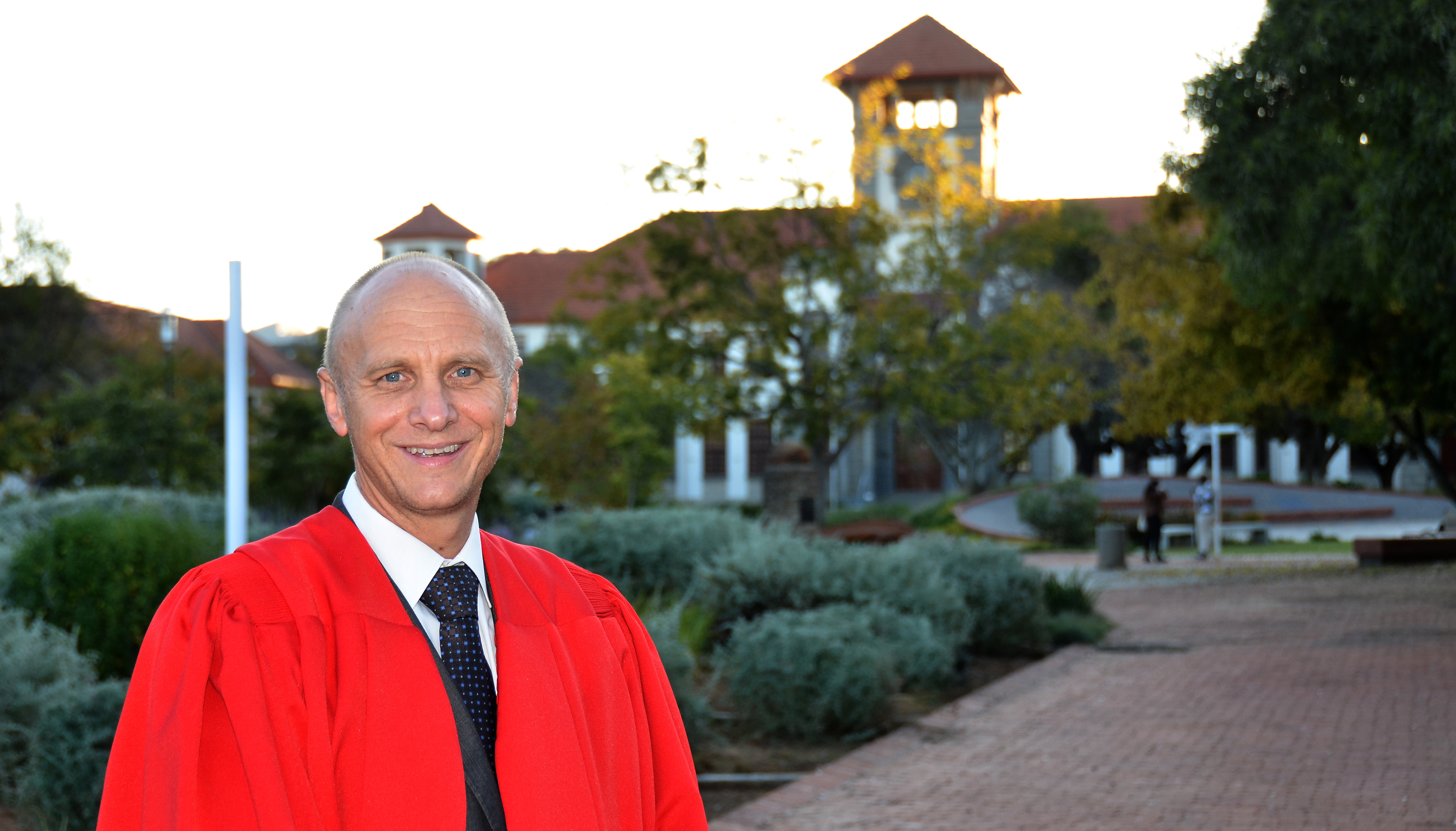Conducting research on weed control for India at the Scottish Agricultural College in Scotland, studying soybean at the International Institute of Tropical Agriculture in Nigeria, and working with genetically modified crops at Agrosystems Research, Dienst
Landbouwkundig Onderzoek (DLO) in Wageningen in the Netherlands, grain legumes in sub-Saharan Africa, and potatoes in South Africa.
More specifically, sustainable agriculture is his passion and the focus of his life’s work. In celebration of his academic career, this was also the topic of his inaugural lecture: Contested Science for Sustainable Agriculture, delivered
on the Bloemfontein Campus on 4 May 2022.
With years of experience in the field, he reflected on sustainable agriculture, firstly stating that it would be good if we could have discussions on sustainable agriculture and the future of agriculture based on empirical evidence. “However, the
reality is that ideology and a strong involvement of non-specialists is unavoidable,” he says.
Secondly, he adds, it would be a major improvement if we could move away from embracing universal principles for farming practices and forcing them into a local context. “It would be better if local contexts and aspirations could guide the way in
which general production principles are applied.” Adding to that, he states the importance of measurements. “If you want to embrace the concept of sustainability, you must be able to measure it.”
Solutions to environmental problems
In his lecture, he took the audience back to years ago when he was doing his master’s research on organic farming systems, excited about organic agriculture as an approach that holds the promise of tackling major environmental problems in a radical
manner. This bout of excitement about the prospects of organic agriculture was, however, short-lived. Fed up with the “dogmatic and anti-science attitude and the tribalism in the sector”, he saw his flirt with organic agriculture as youthful
foolishness.
After spending years in India and Nigeria, Prof Franke produced reports on the sustainability and trade impacts of genetically modified crops. People in the organic and green movement, however, have expressed opposed views. “In their eyes, I was
one of those short-sighted scientists unable to recognise the dangers of genetically modified (GM) crops.”
Investments in regenerative agriculture have become a means to reduce the pressure to invest in curbing greenhouse gas emissions from fossil fuel use elsewhere. – Prof Linus Franke
This made him wonder what drives these polarised discussions on GM crops and sustainable agriculture in general. “I learned that the strong and almost irrational position that the green movement has taken against GM crops and in favour of organic
agriculture is merely a reflection of underlying emotions and preferences,” he says.
He explains two different lines of thinking about how to deal with the ecological challenges associated with agriculture, namely looking at nature to find solutions to environmental problems associated with agriculture, versus the idea that technology
will come to our rescue. “The ecological problems we face in relation to agriculture are caused by modern farming technologies. Genetic modification is seen as an extension of the technologies that were responsible for the problems in the first
place. To solve the problem, we need to look back at nature, learn from nature, and apply ecological principles to farming. You could argue that this view is rather unscientific and techno phobic. But believing that new technologies will come to recue
us in the looming ecological crisis is equally based on a gut feeling, there are no guarantees that this will happen.”
Regenerative agriculture
Despite the strong position taken by the green movement in favour of organic agriculture, the organic movement became stagnant. “In Europe it represents only 5% of the total agricultural production and in South Africa it never really took off. GM
crops have been relatively easily accepted here.”
GM crops and organic agriculture may not be major issues in South Africa, but regenerative agriculture has become a big topic and the discussion and dynamics around regenerative agriculture resemble those around organic agriculture.

Prof Linus Franke delivered his inaugural lecture on the topic Contested Science for Sustainable Agriculture. (Photo: Stephen Collett)
"Over time, new approaches to agriculture have emerged, promising radical improvements in sustainability. Including conservation agriculture, holistic grazing, permaculture, and agro-forestry, these new approaches are grouped under the flag of regenerative
farming and are attracting much attention. This has stimulated interest in using knowledge of ecological processes to improve agricultural production.
“This is truly positive,” states Prof Franke. “It is great to see farmers in South Africa coming together and thinking about ways to apply some of these principles in their farming practices.”
Many of these approaches have proven their merits, but only under certain conditions. “Although many see regenerative farming approaches as globally applicable solutions to the big ecological challenges of today, it is important to take note of
the context and the empirical evidence of the claimed benefits. Inspiration by nature does not necessarily lead to farming practices that are ecologically superior,” he says.
Conservation agriculture, for instance, worked on large-scale mechanised crop farms in Australia and the Americas and it gained a firm foothold in the Western Cape. “But in Africa, including South Africa, conservation agriculture is widely promoted
among smallholders, often with disappointing results,” he says.
Another challenge he addressed during his lecture, was that of expectations of regenerative agriculture being way beyond what farmers actually achieve. He found that large food corporations had announced major investments in regenerative agriculture,
and by doing so, hoped to reduce their carbon footprint regarding production activities. The big issue here is that it is highly uncertain and questionable whether these improvements in carbon sequestration can be achieved. Prof Franke believes that
for some companies, investments in regenerative agriculture have become a means to reduce the pressure to invest in curbing greenhouse gas emissions from fossil fuel use elsewhere.
Watch recording of the Inaugural Lecture below: